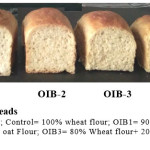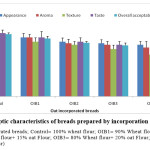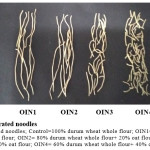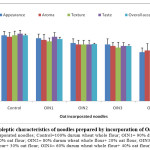Introduction
Oat (Avena sativa L.) is unique among the cereals due to its richness in nutritional components and multifunctional characteristics. Nutritional importance of oats has been revealed due to abundant innovation in food and nutrition. It has been reported to be a good source of dietary fiber especially β-glucan, minerals, proteins and other nutrients.1 It is normally used as animal feed and to a lesser extent as human food. But its use as animal feed has been decreasing slowly due to increased awareness about potential benefits of oats for human health.2 Oat has gained considerable attention for its high content of phytochemicals, dietary fibres, and nutritional value.3 It contains higher amounts of protein, lipids, minerals and β-glucan, a mixed-linkage polysaccharide, which constitutes an important part of oat dietary fiber. It also contains various other phyto-constituents like flavonoids, avenanthramides, flavonolignans, saponins, sterols, triterpenoid and tocols. Oat possesses different pharmacological activities like antioxidant, anti-inflammatory, wound healing, immune-modulatory, anti-diabetic and anti-cholesterolaemic. All these biological activities indicate that oat is a potential therapeutic agent.4 Moreover, due to lack of gluten, it is of great importance in celiac disease. The inclusion of oat bran and grains in the food products improves not only the nutrition but also acts as a therapy against different lifestyle diseases.1 Oat is a major source of functional food ingredients and health benefits of functional foods are supported by adequate scientific authentication and it can serve as an important constituent of functional foods for promotion of healthy lifestyle in society.5
With several reports of health benefits of this important nutritional crop, there is an immense scope of its application in preparation of various nutraceutical and functional foods. Processing of oats is limited mainly to pearling, flaking, heat processing and superheated steam processing but incorporation of oat in other cereals for development of value added processed products is still lacking in literature. Therefore, present investigation was undertaken to study the effect of incorporation of oat flour on nutritional and organoleptic characteristics of oat.
Materials and Methods
The oat cultivar ‘Kent’ procured from Punjab Agriculture University, Ludhiana was utilized in the present investigation. The baking material including wheat flour, hydrogenated vegetable oil, crystal sugar, food grade NaCl and weikfield baking powder of standard manufacturers were procured from local market. Dry yeast (Saccharomyces cerevisiae L.) was obtained from local bakery and stored in refrigerator.
The study was designed to incorporate oat flour in wheat flour at different levels to check the acceptable level of incorporation of oat flour my means of organoleptic evaluation. The products were subjected to nutritional analysis by following standard protocols. Moisture content was determined by air-oven drying method.6 Dry gluten was estimated by following the method of AACC (1984). Ash content, crude fibre, crude fat and crude proteins were determined as per methods described by Ranganna.7 Carbohydrate content was determined by difference after determination of moisture, proteins, fat, ash and crude fibre. Calorific value was determined based on the contents of crude protein (N × 6.25), fats and carbohydrates using the atwater factors (commonly applied to estimate the metabolizable energy content of foods) of 4.0, 9.10 and 4.2 KCal/g of each component, respectively.8 Loaf volume of bakery products such as bread and cake was determined by rapeseed (Brassica napus L.) displacement method. The organoleptic evaluation was conducted by a semi-trained panel for colour, appearance, aroma, texture and taste by a panel of 15 people.7
Statistical analysis
One way analysis of variance (ANOVA) was used to assess data using SPSS 16.0 software. Values were expressed as ± Standard Deviation and differences were considered significant at level of p ≤ 0.05.
Preparation of oat incorporated bread
Various blends were prepared for making bread by incorporation of oat flour. Wheat flour was substituted at 0, 10, 15, 20 and 25 % level with oat flour so as to prepare different blends of oat incorporated bread (OIB) such as control (100% WF); OIB1( 90% WF + 10% OF); OIB2 (85% WF + 15% OF); OIB3 (80% WF + 20% OF) and OIB4 (75% WF +25% OF). Straight dough method was used for making bread. The ingredients used for preparation of bread includes wheat flour or blend (100 g), Sugar (6 g), Yeast (2.5 g), Fat (3 g), Salt (1.5 g), Water (60 ml), Glycerol monosterate (0.5%) and potassium bromate (40 ppm).
Yeast was dissolved in a small part of warm water (35°C) containing 3 g sugar and held for 10 min. The remaining water was used to dissolve remaining sugar and salt. All the ingredients were mixed in a dough mixer at room temperature for 2 min and dough was kept for fermentation at 32°C and 85% relative humidity (RH) in the fermentation cabinet for 90 min. After punching, second fermentation was then carried out for 30 min. The loaves were mechanically moulded and proofed at 30°C and 85 % RH for 25 min. Baking time was 25 min at 220°C in a baking oven. Loaf volume was measured by rapeseed displacement method, one hour after baking. Bread were sliced and packed in polypropylene pouches (100 gauge) heat sealed (Fig. 1).
 |
Figure 1: Oat incorporated breads (OIB= Oat incorporated breads; Control= 100% wheat flour; OIB1= 90% Wheat flour+ 10% oat Flour; OIB2= 85% Wheat flour+ 15% oat Flour; OIB3= 80% Wheat flour+ 20% oat Flour; OIB4 =75% Wheat flour+25% oat Flour) |
Preparation of oat incorporated noodles
Various blends were prepared for making noodles by incorporation of oat flour. Wheat flour was substituted at 0, 10, 20, 30 and 40% level with oat flour so as to prepare different blends of oat incorporated bread (OIB) such as control (100% WF); OIN1( 90% WF + 10% OF); OIN2 (80% WF + 20% OF); OIN3 (70% WF + 30% OF) and OIN4 (60% WF +40% OF). The ingredients used for preparation of bread include durum whole wheat flour or blend (100 g), water (35 ml) and Salt (2 g). Dry mixing of oat flour, wheat flour and salt was done to prepare a homogeneous mixture. Dough was then prepared with water and it was allowed to rest for 1 h. noodles were then prepared in noodle/pasta making machine (SANCO). These were then subjected to steaming for 10 min and allowed to dry in hot air oven at a temperature of 50°C. Noodles were then cooled and packed in polypropylene pouched and heat sealed (Fig 3). These were then stored at room temperature (21-32°C) for further study. For sensory evaluation, dried noodles (100 g) were cooked for 18 min in 1 L water and drained for removal of extra water. Sensory tests were conducted 10 min after draining by a semi-trained panel of 15 people.
 |
Figure 2: Organoleptic characteristics of breads prepared by incorporation of oat flour (OIB= Oat incorporated breads; Control= 100% wheat flour; OIB1= 90% Wheat flour+ 10% oat Flour; OIB2= 85% Wheat flour+ 15% oat Flour; OIB3= 80% Wheat flour+ 20% oat Flour; OIB4 =75% Wheat flour+25% oat Flour) |
 |
Figure 3: Oat incorporated noodles (OIN=Oat incorporated noodles; Control=100% durum wheat whole flour; OIN1= 90% durum wheat whole flour+ 10% oat flour; OIN2= 80% durum wheat whole flour+ 20% oat flour; OIN3= 70% durum wheat whole flour+ 30% oat flour; OIN4= 60% durum wheat whole flour+ 40% oat flour) Click here to View figure |
Results and Discussions
Physico-chemical composition of WF and OF (Kent) is presented in Table 1. There was significant difference in the proximate composition of OF and WF utilized for preparation of oat incorporated bread and noodles. Values were higher for crude fat in OF (4.42%) as compared to WF for bread (1.20%) and noodle (2.06%) preparation. Whereas crude fibre contents were lower for WF for bread (0.40%) and noodle (1.82%) preparation as compared to OF (6.16%). Values for crude protein contents were higher in OF (15.46%) as compared to WF for bread (10.32%) and noodle (11.53%) preparation. Whereas, values for carbohydrates were found to significantly lower in OF (61.51%) as compared to WF used for bread (74.74%) and noodle (71.31%) preparation. Therefore, proximate analysis concluded that OF was significantly higher in crude fibre, crude fat and crude proteins but lower in carbohydrates in comparison to WF. Water absorption capacity (WAC) for WF was lower for bread (0.93 ml/g) and noodle (1.40 ml/g) flour than OF i.e. 3.20 ml/g due to high fibre content present in oat flour.
Physico-chemical parameters of oat incorporated bread after processing are presented in Table 2. The data shows changes in physical parameters such as weight and loaf volume of bread with incorporation of oat in bread. Weight was found to be highest in OIB4 (150.17g) and lowest in control (143.20g). It might be due to high water absorption capacity of increased fibre content in OIB4 and hence resulted in increased weight of OIB4 than control bread. There was decrease in loaf volume of bread from 332.67 to 316.33 cm3 with increase in level of oat flour (Fig.1). It may be due to the dilution effect of non-wheat flour on gluten content of wheat flour and has been expressed as decrease in loaf volume when using composite flours for bread preparation.9 This finding is consistent with previous work comparing the loaf volume of oat and wheat breads.10,11 Similar results were obtained during measurement of loaf volume of fenugreek-supplemented bread by Sharma and Chauhan.12 when increasing the level of replacement of wheat flour with fenugreek flour.
 |
Figure 4: Organoleptic characteristics of noodles prepared by incorporation of Oat flour (OIN=Oat incorporated noodles; Control=100% durum wheat whole flour; OIN1= 90% durum wheat whole flour+ 10% oat flour; OIN2= 80% durum wheat whole flour+ 20% oat flour; OIN3= 70% durum wheat whole flour+ 30% oat flour; OIN4= 60% durum wheat whole flour+ 40% oat flour) Click here to View figure |
Chemical composition of oat incorporated bread is depicted in Table 2. It shows that there was increase in moisture content of bread with increasing the level of incorporation of oat. The moisture content ranged between 25.87% for control to 32.46% for OIB4. Dreese and Hoseney13 and Haridas Rao and Rao14 reported that high water absorption is a characteristics feature of fibre-supplemented flours. Similar Increase in moisture content of bread with increasing the level of substitution of wheat flour with puffed bengalgram flour and fenugreek flour were reported by Rathna and Neelakantan15 and Sharma and Chauhan12 respectively.
The ash content increased from 0.72% in control to 1.53% in OIB4. Significant increase in ash content with increasing the level of oat powder was mainly due to higher ash content of oat than wheat flour. Crude fat and crude fibre content of bread increased with increasing the level of oat flour which might be due to higher content of these components in oat flour. Lowest crude fat (4.38%) and crude fibre (1.63%) content was observed in control samples whereas OIB4 contained the highest crude fat (5.85%) and crude fibre (2.46%) contents. Increase in fibre content of bread was reported by Rathna and Neelakantan.15 when increasing the level of puffed Bengal gram flour in bread. Increased crude fibre contents of bread will be highly desirable for diabetic and heart patients and will help in management of blood sugar and cholesterol level.
There was significant increase in crude protein content of bread with increase in oat flour. It might be due to high protein content of oat as compared to wheat flour. Crude protein content ranged from 9.45% in control to 11.18% in OIB4. Similar increase in crude protein content was observed in bread and biscuits enriched with mushroom powder.16, 17 The carbohydrate content of oat incorporated bread decreased from 57.95% (control) to 46.52% (OIB4) which was mainly due to lower content of carbohydrate in OF as compared to WF (Table 1). There was decrease in calorific value of bread with increasing the level of oat flour. Decline in the calorific value (321.02-293.37 Kcal/g) of OIB was mainly due to decreased carbohydrate content.
Table 1: Physico-chemical composition of oat flour (Kent) and wheat flour used in bread and noodle preparation
| Parameters | Wheat flour (bread preparation ) | Durum wheat flour (noodle preparation) | Oat (KENT) Flour |
| Moisture (%) | 12.82±0.11a | 11.50±0.26b | 10.52±1.20b |
| Crude Protein (%) | 10.32±0.16c | 11.53±0.25b | 15.46 ±0.31a |
| Crude Fat (%) | 1.20±0.02c | 2.06±0.12b | 4.42±0.51a |
| Crude fibre (%) | 0.40±0.05c | 1.82±0.11b | 6.16±0.23a |
| Ash (%) | 0.52±0.10c | 1.78±0.05a | 1.93±0.05a |
| Carbohydrates (%) | 74.74±0.38b | 71.31±0.06c | 61.51±0.91d |
| Dry gluten (%) (for noodle) | 09.30±0.20b | 10.37±0.15a | NIL |
| SDS sedimentation value | 39.52±0.10a | 30.33±0.58b | 28.33±0.58c |
| Water Absorption Capacity (WAC) (ml/g) | 0.93±0.15c | 1.40±0.10b | 3.20±0.10a |
Values in the table are presented as mean±SD; Values with in rows sharing the same letters are not significantly different according to Duncan’s LSD post hoc analysis at P≤0.05 Oat bread was subjected to organoleptic evaluation by panel of 15 people and the data is shown in Fig 2. There was decrease in overall acceptability of breads with increase in level of oat flour and overall acceptability scores for all treatments ranged from 6.35 to 8.65. However breads were desirable only up to 20% replacement of wheat flour with oat flour and slightly desirable thereafter. Gambuś, Gibiński18 utilized residual oat flour as a good source of proteins for the production of white bread, and found that it could be used in the amounts up to 20% of wheat flour mass. Flander, Salmenkallio-Marttila19 reported that oat incorporated breads have a mild, nutty and pleasant flavor. Oats have also been reported to have an excellent moisture retention property that keeps bread fresh for longer period.20 Incorporation of oat lecithin or oat starch to wheat bread was reported to slow down the staling rate of the bread.21
Physico-chemical parameters of oat incorporated noodle after processing are presented in Table 3. It was observed that there was more breakage in noodles with increase in amount of incorporation of oat flour in noodles (Fig. 3). It might be due to decreased amount of gluten content in noodles leading to decreased binding and more breakage of product. The moisture content ranged between 4.56% (Control) to 5.52% (OIN4). The ash content increased from 1.12% (Control) to 2.53% (OIN4) with increasing the level of oat. There was increase in crude fibre content of noodles with increasing the level of oat in wheat flour. Values for Crude fibre contents increased from 2.43% (control) to 4.26% (OIN4). Increase in ash and crude fibre content with increasing the level of oat flour was mainly because of higher ash and crude fibre content of oat flour than wheat flour.
Table 2: Physico-chemical composition of breads prepared by incorporation of oat flour
| Parameters | Control | OIB1 | OIB2 | OIB3 | OIB4 |
| Moisture (%) | 25.87±0.74e | 27.99±0.30d | 30.40±0.39c | 31.54±0.06b | 32.46±0.06a |
| Ash (%) | 0.72±0.08c | 0.77±0.11c | 0.82±0.07c | 1.16±0.02b | 1.53±0.02a |
| Crude fat (%) | 4.38±0.38c | 4.62±0.05c | 5.25±0.08b | 5.73±0.08a | 5.85±0.05a |
| Crude fibre (%) | 1.63±0.23c | 1.53±0.04c | 1.74±0.13c | 2.13±0.05b | 2.46±0.15a |
| Crude protein (%) | 9.45±0.13e | 9.65±0.15d | 10.18±0.02c | 10.53±0.12b | 11.18±0.04a |
| Carbohydrates (%) | 57.95±1.29a | 55.43±0.38b | 51.62±0.42c | 48.91±0.17d | 46.52±0.15e |
| Calorific value (Kcal/g) | 321.02±2.63a | 313.48±0.86b | 305.24±1.12c | 299.68±0.43d | 293.37±0.26e |
| Weight (g) | 143.20±0.26d | 145.27±1.12c | 146.60±1.85bc | 148.17±0.85ab | 150.17±0.76a |
| Loaf Volume (cm3) | 332.67±1.53a | 325.67±2.08b | 321.33±1.53c | 319.0±2.00cd | 316.33±2.52d |
Values in the table are presented as mean±SD; Values with in rows sharing the same letters are not significantly different according to Duncan’s LSD post hoc analysis at P≤0.05, OIB= Oat incorporated breads; Control= 100% wheat flour; OIB1= 90% Wheat flour+ 10% oat Flour; OIB2= 85% Wheat flour+ 15% oat Flour; OIB3= 80% Wheat flour+ 20% oat Flour; OIB4 =75% Wheat flour+25% oat Flour.
Values for crude fat contents increased from 1.23% (Control) to 3.28% (OIN4) with increasing the level of oat. Also, due to high protein content of oat flour than wheat flour, there was increase in protein content of noodles with increased incorporation of oat. Values for crude protein varied from 10.35 to 13.19%. On the other hand, there was significant decrease (80.32-71.23%) in the carbohydrates content of noodles. There was slight decrease in calorific value of oat incorporated noodles and values varied in the range of 381.74 Kcal/100g (OIN4) to 494.82 Kcal/100g (control). Aydin and Gocmen22 reported that oat flour addition significantly increased the ash content of noodles prepared by incorporation of egg and oat flour especially at the levels of 20, 30, and 40%. They further found that ash, protein, and crude fat contents were the highest in the sample containing 40% oat flour. They attributed it to the higher ash, protein, and crude fat contents of oat flour. Due to high protein contents of OIN, these will be helpful for prevention and treatment of protein- energy malnutrition (PEM) diseases such as kwashiorkor and merasmus in children.
Organoleptic evaluation of oat incorporated noodles after processing is given in Fig. 4. Noodles were subjected to organoleptic evaluation by a semi-trained panel. The overall acceptability for all treatments ranged between 6.35-8.60%. There was slight decrease in overall acceptability of noodles with increase in level of oat flour. However noodles were desirable up to 30% replacement of wheat flour with oat flour and slightly desirable thereafter. Mittal23 reported that oat incorporated matthi were moderately acceptable at 35% level of incorporation of oats.
Table 3: Chemical composition of noodles prepared by incorporation of oat flour
| Parameters | Control | OIN1 | OIN2 | OIN3 | OIN4 |
| Moisture (%) | 4.56±0.09c | 4.65±0.11c | 5.07±0.17b | 5.35±0.09a | 5.52±0.18a |
| Crude protein (%) | 10.35±0.49d | 11.25±0.13c | 12.02±0.14b | 12.88±0.32a | 13.19±0.36a |
| Crude fat (%) | 1.23±0.08e | 1.65±0.12d | 2.31±0.12c | 2.64±0.09b | 3.28±0.16a |
| Ash (%) | 1.12±0.10e | 1.62±0.09d | 2.04±0.07c | 2.29±0.07b | 2.53±0.20a |
| Crude fibre (%) | 2.43±0.10d | 2.75±0.09c | 3.52±0.11b | 3.70±0.15b | 4.26±0.16a |
| Carbohydrates (%) | 80.32±0.58e | 78.08±0.20d | 75.03±0.21c | 73.14±0.30b | 71.23±0.46a |
| Calorific value (Kcal/100g) | 389.88±1.03c | 387.95±0.86bc | 384.25±1.27b | 382.76±0.79a | 381.74±1.66a |
Values in the table are presented as mean±SD; Values with in rows sharing the same letters are not significantly different according to Duncan’s LSD post hoc analysis at P≤0.05, OIN=Oat incorporated noodles; Control=100% durum wheat whole flour; OIN1= 90% durum wheat whole flour+ 10% oat flour; OIN2= 80% durum wheat whole flour+ 20% oat flour; OIN3= 70% durum wheat whole flour+ 30% oat flour; OIN4= 60% durum wheat whole flour+ 40% oat flour
Summary and Conclusions
Oat flour was incorporated successfully for preparation of value added functional foods like bread and noodles. Organoleptic evaluation of products concluded that bread and noodles were moderately desirable up to 20 and 30% replacement of wheat flour with oat flour, respectively. Significant increases in protein, ash, crude fat and crude fibre contents with increasing the level of oat flour in processed products were mainly because of higher protein, ash, crude fibre and fat content of oat flour than that of wheat flour. Incorporation of oat flour in wheat flour increased the protein, crude fibre, fat and mineral components. Oat is underutilized cereal and utilization of oat in the daily diet at present is largely restricted to oat flakes or porridges. Unavailability of products to the taste of urban community is the main reason. Processing the oat for the development of value added and convenient food products would be the possible solution for its promotion, commercialization and enhancement of consumption, nutritional status and thereby increasing profitability and better livelihood to the society.
Acknowledgements
The authors duly acknowledge the ministry of Food Processing Industries (MoFPI) Govt. of India grant for infrastructural facility development (F. No. 5-11/2010-HRD) and Vice Chancellor, Eternal University for providing the motivation and research infrastructure.
References
- Butt, M.S., et al., Oat: unique among the cereals. European journal of nutrition. 47(2): p. 68-79 (2008).
CrossRef - Ahmad, A., et al., Extraction and characterization of β-d-glucan from oat for industrial utilization. International journal of biological macromolecules,. 46(3): p. 304-309 (2010).
CrossRef - Rasane, P., et al., Nutritional advantages of oats and opportunities for its processing as value added foods-a review. Journal of food science and technology 52 (2):p. 662-675 (2015).
CrossRef - Singh, R., S. De, and A. Belkheir, Avena sativa (Oat), a potential neutraceutical and therapeutic agent: an overview. Critical reviews in food science and nutrition. 53(2): p. 126-144 (2013).
CrossRef - Kumar, K., Functional Foods and Lifestyle Diseases. EC Nutrition. 11(6): p. 216-17 (2017).
- AOAC, Official methods of analysis. Association of Official Analytical Chemists, Arlington, VA, USA. 1: p. 684 (1990).
- Ranganna, S., Handbook of analysis and quality control for fruit and vegetable products.: Tata McGraw-Hill Education(1986).
- WHO, F. Energy and protein requirements. in Geneva: FAO/WHO. (FAO) Nutrition Meetings Report Series 52. (1973).
- Chavan, J., S. Kadam, and N.R. Reddy, Nutritional enrichment of bakery products by supplementation with nonwheat flours. Critical Reviews in Food Science & Nutrition. 33(3): p. 189-226 (1993).
CrossRef - Vittadini, E. and Y. Vodovotz, Changes in the Physicochemical Properties of Wheat‐and Soy‐containing Breads During Storage as Studied by Thermal Analyses. Journal of food science. 68(6): p. 2022-2027 (2003).
CrossRef - Buck, J., C. Walker, and K. Watson, Incorporation of corn gluten meal and soy into various cereal-based foods and resulting product functional, sensory, and protein quality. Cereal chemistry (USA), 1987.
- Sharma, H. and G. Chauhan, Physical, sensory and chemical characteristics of wheat breads supplemented with fenugreek (Trigonella foenum graecum L.). Journal of Food Science and Technology. 37(1): p. 91-94 (2000).
- Dreese, P. and R. Hoseney, Baking properties of the bran fraction from brewer’s spent grains. Cereal Chemistry. 59(2): p. 89-91 (1982).
- Haridas Rao, P. and H.M. Rao, Effect of incorporating wheat bran on the rheological characteristics and bread making quality of flour. Journal of Food Science and Technology. 28(2): p. 92-97 (1991).
- Rathna, K. and S. Neelakantan, Effect of incorporation of puffed Bengalgram flour on the quality of bread. Assn Food Scient Techn India Central Food Technol Res Inst, Mysore 570013, INDIA. p. 169-171 (1995).
- Kumar, K. and A. Barmanray, Nutritional Evaluation and storage studies of button mushroom powder fortified bread, in National seminar on food safety and quality: Department of Food Technology, Guru Jambheshwar University of Science and Technology, Hisar-125001, Haryana. p. 292-295 (2008).
- Kumar, K. and A. Barmanray, Nutritional evaluation and storage studies of button mushroom powder fortified biscuits. Proteins. 96: p. 325 (2007).
- Gambuś, H., et al., The application of residual oats flour in bread production in order to improve its quality and biological value of protein. Acta Scientiarum Polonorum Technologia Alimentaria. 10(3): p. 317-325 (2011).
- Flander, L., et al., Optimization of ingredients and baking process for improved wholemeal oat bread quality. LWT-Food Science and Technology. 40(5): p. 860-870 (2007).
CrossRef - McKechnie, R., Oat products in bakery foods. Cereal Foods World, 1983.
- Zhang, D., W. Moore, and D. Doehlert, Effects of oat grain hydrothermal treatments on wheat-oat flour dough properties and breadbaking quality. Cereal Chemistry. 75(5): p. 602-605 (1998).
CrossRefz - Aydin, E. and D. Gocmen, Cooking quality and sensorial properties of noodle supplemented with oat flour. Food Science and Biotechnology. 20(2): p. 507-511 (2011).
- Mittal, S., Organoleptic and nutritional evaluation of gluten free products for celiac disease patients. PAU Ludhiana (2011).

This work is licensed under a Creative Commons Attribution 4.0 International License.






